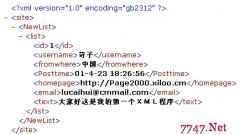ASP的常用函数
来源:网络收集 责任编辑:admin 发表时间:2013-07-01 22:29 点击:次
Array()
函数返回一个数组
表达式 Array(list)
允许数据类型: 字符,数字均可
实例: <%
Dim myArray()
For i = 1 to 7
Redim Preserve myArray(i)
myArray(i) = WeekdayName(i)
Next
%>
返回结果: 建立了一个包含7个元素的数组myArray
myArray("Sunday","Monday", ... ... "Saturday")
CInt()
函数将一个表达式转化为数字类型
表达式 CInt(expression)
允许数据类型: 任何有效的字符均可(不大于32767)
实例: <%
f = "234"
response.write cINT(f) + 2
%>
返回结果: 236
转化字符"234"为数字"234",如果字符串为空,则返回0值
createObject()
函数建立和返回一个已注册的ACTIVEX组件的实例。
表达式 createObject(objName)
允许数据类型: objName 是任何一个有效、已注册的ACTIVEX组件的名字.
实例: <%
Set con = Server.createObject("ADODB.Connection")
%>
CStr()
函数转化一个表达式为字符串.
表达式 CStr(expression)
允许数据类型: expression 是任何有效的表达式。
实例: <%
s = 3 + 2
response.write "The 返回结果 is: " & cStr(s)
%>
返回结果: 转化数字"5"为字符"5"。
Date()
函数返回当前系统日期.
表达式 Date()
允许数据类型: None.
实例: <%=Date%>
返回结果: 9/9/00
DateAdd()
函数返回一个被改变了的日期。
表达式 DateAdd(timeinterval,number,date)
允许数据类型:
timeinterval is the time interval to add;
number is amount of time intervals to add;
and date is the starting date.
实例: <%
currentDate = #9/9/00#
newDate = DateAdd("m",3,currentDate)
response.write newDate
%>
<%
currentDate = #12:34:45 PM#
newDate = DateAdd("h",3,currentDate)
response.write newDate
%>
返回结果: 9/9/00
3:34:45 PM
"m" = "month";
"d" = "day";
If currentDate is in time format then,
"h" = "hour";
"s" = "second";
DateDiff()
函数返回两个日期之间的差值 。
表达式 DateDiff(timeinterval,date1,date2 [, firstdayofweek [, firstweekofyear]])
允许数据类型: timeinterval 表示相隔时间的类型,如"M"表示"月"。
实例: <%
fromDate = #9/9/00#
toDate = #1/1/2000#
response.write "There are " & _
DateDiff("d",fromDate,toDate) & _
" days to millenium from 9/9/00."
%>
返回结果: 从9/9/00 到2000年还有 150 天.
Day()
函数返回一个月的第几日 .
表达式 Day(date)
允许数据类型: date 是任何有效的日期。
实例: <%=Day(#9/9/00#)%>
返回结果: 9
formatCurrency()
函数返回表达式,此表达式已被格式化为货币值
表达式 formatCurrency(Expression [, Digit [, LeadingDigit [, Paren [, GroupDigit]]]])
允许数据类型: Digit 指示小数点右侧显示位数的数值。默认值为 -1,指示使用的是计算机的区域设置; LeadingDigit 三态常数,指示是否显示小数值小数点前面的零。
实例: <%=formatCurrency(34.3456)%>&nb
函数返回一个数组
表达式 Array(list)
允许数据类型: 字符,数字均可
实例: <%
Dim myArray()
For i = 1 to 7
Redim Preserve myArray(i)
myArray(i) = WeekdayName(i)
Next
%>
返回结果: 建立了一个包含7个元素的数组myArray
myArray("Sunday","Monday", ... ... "Saturday")
CInt()
函数将一个表达式转化为数字类型
表达式 CInt(expression)
允许数据类型: 任何有效的字符均可(不大于32767)
实例: <%
f = "234"
response.write cINT(f) + 2
%>
返回结果: 236
转化字符"234"为数字"234",如果字符串为空,则返回0值
createObject()
函数建立和返回一个已注册的ACTIVEX组件的实例。
表达式 createObject(objName)
允许数据类型: objName 是任何一个有效、已注册的ACTIVEX组件的名字.
实例: <%
Set con = Server.createObject("ADODB.Connection")
%>
CStr()
函数转化一个表达式为字符串.
表达式 CStr(expression)
允许数据类型: expression 是任何有效的表达式。
实例: <%
s = 3 + 2
response.write "The 返回结果 is: " & cStr(s)
%>
返回结果: 转化数字"5"为字符"5"。
Date()
函数返回当前系统日期.
表达式 Date()
允许数据类型: None.
实例: <%=Date%>
返回结果: 9/9/00
[NextPage]
DateAdd()
函数返回一个被改变了的日期。
表达式 DateAdd(timeinterval,number,date)
允许数据类型:
timeinterval is the time interval to add;
number is amount of time intervals to add;
and date is the starting date.
实例: <%
currentDate = #9/9/00#
newDate = DateAdd("m",3,currentDate)
response.write newDate
%>
<%
currentDate = #12:34:45 PM#
newDate = DateAdd("h",3,currentDate)
response.write newDate
%>
返回结果: 9/9/00
3:34:45 PM
"m" = "month";
"d" = "day";
If currentDate is in time format then,
"h" = "hour";
"s" = "second";
DateDiff()
函数返回两个日期之间的差值 。
表达式 DateDiff(timeinterval,date1,date2 [, firstdayofweek [, firstweekofyear]])
允许数据类型: timeinterval 表示相隔时间的类型,如"M"表示"月"。
实例: <%
fromDate = #9/9/00#
toDate = #1/1/2000#
response.write "There are " & _
DateDiff("d",fromDate,toDate) & _
" days to millenium from 9/9/00."
%>
返回结果: 从9/9/00 到2000年还有 150 天.
Day()
函数返回一个月的第几日 .
表达式 Day(date)
允许数据类型: date 是任何有效的日期。
实例: <%=Day(#9/9/00#)%>
返回结果: 9
[NextPage]
formatCurrency()
函数返回表达式,此表达式已被格式化为货币值
表达式 formatCurrency(Expression [, Digit [, LeadingDigit [, Paren [, GroupDigit]]]])
允许数据类型: Digit 指示小数点右侧显示位数的数值。默认值为 -1,指示使用的是计算机的区域设置; LeadingDigit 三态常数,指示是否显示小数值小数点前面的零。
实例: <%=formatCurrency(34.3456)%>&nb
相关新闻>>
最新推荐更多>>>
- 发表评论
-
- 最新评论 进入详细评论页>>


